Working in rows
To work to and fro in rows make a foundation chain (see here) to begin. It can be very frustrating to be approaching the end of a long first row only to discover that you have miss-counted and there are too few chains in the base chain to complete it. Leave a generous end of yarn when making your initial slip knot; then it is simple to remove your hook temporarily from the working loop, insert it through the end of the base chain and, using the spare end of yarn, to add the necessary chains.
1. The first row of the fabric is made by working across the base chain as shown in The Basic Stitches’. (Right handers work from right to left; left handers work from left to right). Insert hook under either one (Fig.109) or two (Fig.110) of the three threads, which make up each individual chain. Choose which you find suits you best and then be consistent.
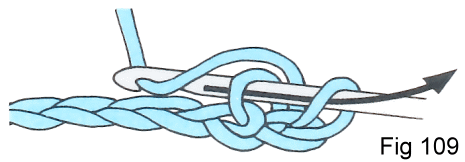
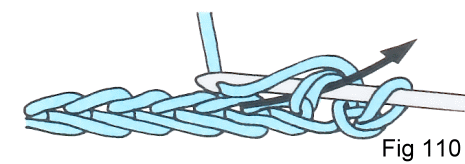
At the very beginning of the first row, in order to give the first stitch room to stand up to its proper height, one or more of the base chains is ‘missed’. These then bend and stand up alongside the stitches. Together they look like and may often ‘count’ as the first stitch in the row (Fig.111). The number of chains missed depends upon the height of the stitch they are to match as follows: double crochet = 1 or 2 chains missed; half treble = 2 chains missed; treble = 3 chains missed; double treble = 4 chains missed; triple treble = 5 chains missed. For this and other reasons you must expect to make a larger number of chains for the base chain than there are stitches required in the base row.
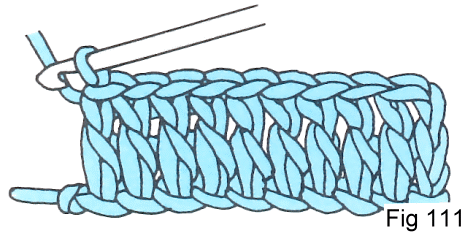
2. At the end of each row ‘turn’ the work so that another row can be worked across the top of the previous one again from right to left (left handers from left to right) (Fig.112). It does not matter which way you turn, but it helps to be consistent.
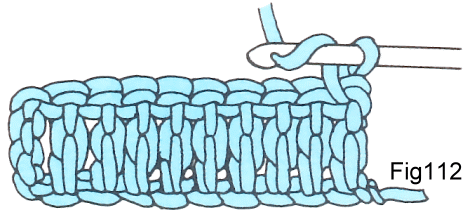
Before the new row can begin a ‘turning chain’ (one or more single chains) must be worked to bring the hook up to the height the row will be. The number of chains for turning depends upon the height of the stitch they are to match as follows: double crochet = 1 chain; half treble = 2 chains; treble = 3 chains; double treble = 4 chains; triple treble = 5 chains. These numbers are guidelines only. Depending on your personal technique, the type of work you are doing, the thickness of yarn and size of hook you are using, you may find from time to time a larger or smaller number of chains gives better results. 3. The turning chain may also count as the first stitch in the new row. In this case miss the first stitch in the previous row (Fig.113) but remember to work a stitch into the top of the previous turning chain when you reach the end of the row (Figs 114 and 115). If the turning chain does not count as a stitch, work into the first stitch at the beginning of the row, but not into the top of the previous turning chain at the end.
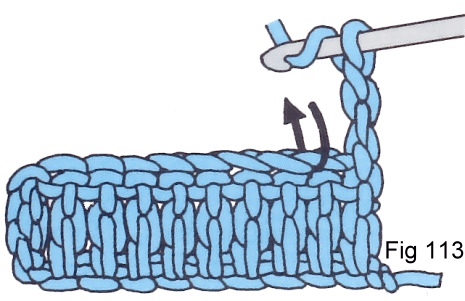
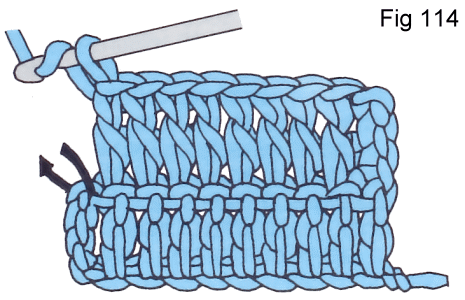
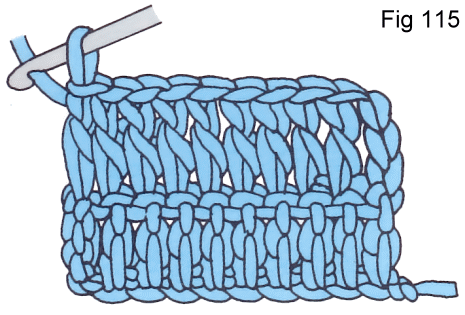
To make each stitch insert the hook under the two loops lying on top of each stitch in the previous row. (Instructions always specify if you are to insert the hook in any other place).
All content provided by TB Ramsden & Co.